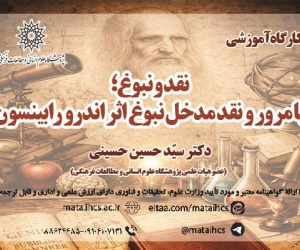جنبش مینگی و معیارهای زیبایی آن، در سفال ژاپن (مقاله علمی وزارت علوم)
درجه علمی: نشریه علمی (وزارت علوم)
آرشیو
چکیده
مینگی جنبش پیشه های هنرمندانی است که به ساخت اشیاء معمولی(دست ساز- بومی) می پردازند. این جنبش توسط یاناگی سوئتسو و همکارانش، در فواصل سال های 1920-1930، جهت حفظ آثار دستی در جریان مدرنیزاسیون ژاپن پایه گذاری شد. جنبش مینگی، درهنر- صنعت سفال و سرامیک در دنیا بسیار شناخته شده است، اما در ایران، ناشناخته مانده است. این مقاله ضمن شرح جنبش مینگی و نحوه ی شکل گیری آن، درصدد است معیارهای زیبایی آن را معرفی، و ضمن تحلیل سرامیک های مینگی، به ریشه یابی دلایل پیدایش آنها بپردازد. این پژوهش از روش توصیفی-تحلیلی جهت تحلیل مطالب بهره برده است و گردآوری اطلاعات به شیوه کتابخانه ای صورت پذیرفته است. نتایج حاصل از پژوهش نشان می دهد که، سفالینه های مینگی از زیبایی های ناب برخوردارند و به «نیروی سنت جمعی» تکیه دارد. قدرتی که برمبنای اعتقادات بومی، مذهبی و ملی گرایانه ای چون شینتوئیزم، تائوئیزم و بودیسم استوار است. پیشه ور ناشناس نیز نه آگاهانه، بلکه با کمک طبیعت و سنت، فارغ از هرگونه ادعا و با نهایت خلوص، با مواد طبیعی و با هدف کاربرد، به تولید آثاری ناب و زیبا و در عین حال ارزان و فراوان دست می یازد. فهم این نوع زیبایی، مستلزم درک فلسفه ی زیبایی شناسی جنبش مینگی است. جنبشی که در دوره ی می جی هم زمان با تحولات بنیادی در عرصه های مختلف، زمینه ساز حفظ فرهنگ اصیل ژاپنی و معرفی آن به دنیا شد.The Japanese Mingei Movement and its Criterion of Beauty, On Japanese Ceramics
Mingei Japanese folk craft movement involved in making (folk - handi) crafts by unknown craftman. Although these crafts are prepared for ordinary people in large quantities and cheap prices, possess the purest beauty and privileged specifically. The Japanese movement had its ideological antecedent’s in the larger arts and craft movement at the end of the 19th and early 20th century, so it was global in scope. This movement is founded by Yanagi Soetsu and his attendants. After the mid- 19th century, when Japan was forced to establish more open trade relations with the west, the conceptual separation of art from craft was introduced. During this period of Japanese history, the Meiji Restoration government undertook a policy of rapid industrialization and westernization. Industrialization resulted in the mechanized mass production of formerly hand-made objects and artisans were finding it very difficult to survive in the changing economy. Yanagi soaked up these ideas and after visiting Korea and returning to notice the quick disappearance of traditional crafts in quickly modernizing Tokyo, he launched the movement in 1926 to protect the Japanese handicrafts from the new modernization from 1920-1930. According to Yanagi, utilitarian objects made by the common people are “beyond beauty and ugliness”. In recent decades,scholars such as Yuko Kikuchi and Brian Moeran have uncovered power relations and ultra-nationalism that lie at the core of the formation of Mingei theory. In 1927, Yanagi put forward the “criterion of beauty in Japan. Those scholars argue that Mingei theory, far from being an oriental theory, is a “hybridization” and “appropriation” of occidental ideas such as that of William Morris, which Bernard Leach introduced during his stay in Japan in 1909. The movement developed nationwide campaign for the revival of folk crafts and nourished a cultural ethnic nationalism in new modern Japan. Although the Mingei movement is well known in ceramic art and its educational system in the world, unfortunately as a result of leakage adequate references and researches, it’s not familiar in Iran, so this article is based on describing the Mingei movement and its origins, then explains the criterion of beauty and analyzes the aesthetic aspects of Japanese Mingei ceramics for understanding the existence background. This article uses the library techniques and analyzing the descriptions and study the Japanese folk ceramics under the Mingei Criterion of Beauty. In this way, the conclusions yield, were: the Mingei ceramics possess the purest beauty, for they are supported by tradition power, which based on the native, religious and nationalist beliefs, like Shintoism, Taoism and Buddhism. The unknown craftsman makes his work unawareness, selflessness and honestly, with the nature and divine power and uses natural materials under the functional intention, which results inexpensiveness and plurality. Although Mingei ceramics has simplicity and irregularity in form and design, they have intimacy that provides kind of beauty which surpasses any other kinds and understanding them, needs realizing the aesthetics of Mingei movement. The movement which developed nationwide campaign for the revival of folk crafts and nourished a cultural ethnic nationalism in new modern Japan during Meiji period.









